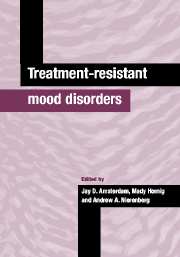Book contents
- Frontmatter
- Contents
- List of contributors
- Preface
- Part I The clinical problem
- Part II Biological basis
- Part III Treatment approaches
- Part IV Special patient populations
- 14 Chronic and refractory mood disorders in childhood and adolescence
- 15 Treatment-resistant depression in the elderly
- 16 Management of treatment-resistant depression during pregnancy and the postpartum period
- 17 Preliminary algorithms for treatment-resistant bipolar depression
- 18 Medical disorders and treatment-resistant depression
- 19 Psychiatric comorbidity in treatment-resistant depression
- 20 Suicide in treatment-refractory depression
- Part V Economic and ethical issues
- Index
- Plate Section
15 - Treatment-resistant depression in the elderly
from Part IV - Special patient populations
Published online by Cambridge University Press: 25 March 2010
- Frontmatter
- Contents
- List of contributors
- Preface
- Part I The clinical problem
- Part II Biological basis
- Part III Treatment approaches
- Part IV Special patient populations
- 14 Chronic and refractory mood disorders in childhood and adolescence
- 15 Treatment-resistant depression in the elderly
- 16 Management of treatment-resistant depression during pregnancy and the postpartum period
- 17 Preliminary algorithms for treatment-resistant bipolar depression
- 18 Medical disorders and treatment-resistant depression
- 19 Psychiatric comorbidity in treatment-resistant depression
- 20 Suicide in treatment-refractory depression
- Part V Economic and ethical issues
- Index
- Plate Section
Summary
Introduction
Surveys of healthy elderly individuals have revealed that 15% of community dwelling elderly report clinically significant degrees of depressed mood, 4% suffer from a major depressive disorder, and 6.5% have depression associated with a significant medical illness (Blazer & Williams, 1980). However, in special settings, the prevalence rates of depressive disorders may bemuch higher. Major depressive disorders have been reported in from 17% (Van Marwijk et al., 1990) to 31% of elderly medical patients in a clinic (Okimoto et al., 1982), and up to 45% in hospitalized elderly (Kitchell et al., 1982). Rapp and colleagues (Rapp et al., 1988) reported that 27% of elderly male patients in a general hospital had a diagnosable psychiatric disorder, most commonly depression. Depression may also contribute to higher overall mortality rates through poor self-care, inadequate compliance with medical treatment, and poorer physical functioning. It has been estimated that up to 20% of non-cognitively impaired individuals in nursing homes suVer from major depressive disorder (Blazer, 1989). The rate among cognitively impaired individuals may be even higher.
The consequences of untreated or inadequately treated depressive disorder in the elderly are serious. Suicide rates rise over the life cycle and increase dramatically in old age. In 1986, the suicide rate for the elderly was 21.6 per 100 000 compared to 12.8 per 100 000 for the general population (Allen & Blazer, 1991). For elderly white males, this rate increases to 40–75 per 100 000 (Katz et al., 1988). Suicide rates for elderly men are Wve times higher than those for elderly women. In addition, morbidity from these disorders is not limited to suicide.
Keywords
- Type
- Chapter
- Information
- Treatment-Resistant Mood Disorders , pp. 288 - 320Publisher: Cambridge University PressPrint publication year: 2001
- 1
- Cited by



